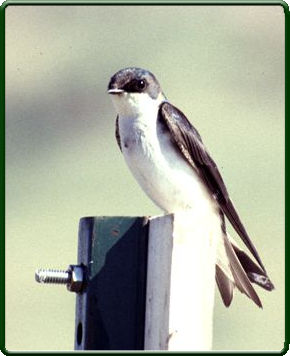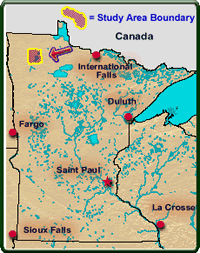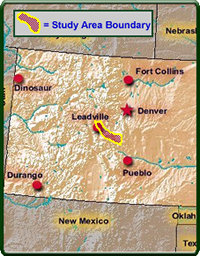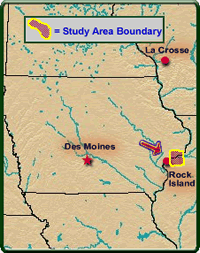Upper Midwest Environmental Sciences Center
|
|
| Home/ Overview/ Science Programs/ Data Library/ Products and Publications/States/ Rivers/Teachers and Students/ Links/ Contact/ Search |
Contaminant Effects on Tree Swallows: A Nationwide Indicator Species
 Swallows, especially tree swallows (Tachycineta bicolor),
are being more widely used as indicators of environmental contamination,
contaminant transfer from sediment and water into higher trophic
levels within the ecosystem, and biological effects. Tree swallows
are an ideal species to study bioavailability and contaminant effects
for several reasons.
Swallows, especially tree swallows (Tachycineta bicolor),
are being more widely used as indicators of environmental contamination,
contaminant transfer from sediment and water into higher trophic
levels within the ecosystem, and biological effects. Tree swallows
are an ideal species to study bioavailability and contaminant effects
for several reasons.
Tree swallows occur across the United States and Canada; therefore, study sites can be established in almost any area of interest. Use of a single species across wide geographic areas can facilitate our ability to transfer research results among locations.
The determination of effect levels for chemicals or classes of chemicals for tree swallows will facilitate the assessment of effects at other sites at much reduced costs. Tree swallows feed near their nest on emergent aquatic insects.
Consequently, residues in their tissues reflect local sediment contamination and the bioavailability of those chemicals.
A nationwide database of information is being developed to facilitate transfer of knowledge about chemical concentrations, effect levels, and movement and effects within ecosystems.
Current study sites include the following:
- Colorado—where historic gold and silver mines near Leadville have contaminated the Arkansas River with lead and possibly other metals.
- Northern Minnesota—where eggs and feathers of several bird species contain high levels of heavy metals, such as cadmium, mercury, and chromium.
- Illinois—where polychlorinated biphenyls have been a known pollutant in the Mississippi River near Rock Island, Illinois.



The study will be completed in September 2007. These projects will assist the U.S. Fish and Wildlife Service and other agencies in determining management options at contaminated sites.
Principal Investigator: Christine Custer



